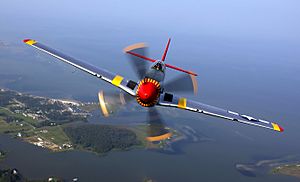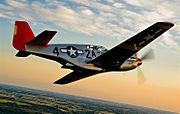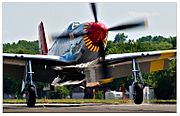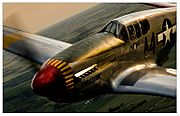Red Tail Squadron facts for kids

Logo prior to 2011
|
|
| Focus | History of the Tuskegee Airmen |
|---|---|
| Location |
|
| Origins | The Commemorative Air Force (CAF) Red Tail Squadron |
| Method | Exhibition |
| Website | CAF Red Tail Squadron |
The Red Tail Squadron is a special group that keeps a World War II airplane flying. This plane is a P-51C Mustang. The group is part of the Commemorative Air Force (CAF), which is a non-profit organization.
The Red Tail Squadron wants to teach people about the brave Tuskegee Airmen. These Airmen were a group of African American pilots who fought in World War II. Their planes had special red tails, which is how the squadron got its name.
The P-51C Mustang has been rebuilt twice. It flies to air shows and events to share the Airmen's amazing story. The Red Tail Squadron also uses a special traveling exhibit to reach more young people.
Contents
Who Were the Tuskegee Airmen?
The Tuskegee Airmen were African American pilots and support staff during World War II. They were part of the U.S. Army Air Corps. People sometimes called them the "Red Tail Angels" because of the red paint on their fighter planes.
At that time, the American military was separated by race. African Americans faced unfair rules and treatment. Despite these challenges, the Tuskegee Airmen flew with great skill and courage.
They flew over 15,000 missions, often protecting bombers. In 2007, many Tuskegee Airmen received the Congressional Gold Medal. This is a very high honor from the U.S. Congress. Their training airfield is now a special historic site.
The P-51C Mustang: A Special Plane
After World War II ended in 1945, the U.S. Army sold off many old military items. Montana State University bought a P-51C aircraft for just $1. It sat on their campus for many years.
In 1965, a restorer named Lloyd Creek bought the plane for $1. He had to move it quickly, so the wings were cut off to transport it. Later, the wings were put back on.
In 1970, Mr. Creek gave the P-51C to the Commemorative Air Force (CAF). The plane was taken apart and shipped to Texas. It even survived a hurricane, which damaged some parts.
Bringing the P-51C Back to Life
Many volunteers tried to restore the plane over the years. In the late 1980s, Don Hinz took charge of the project. He had a vision to restore the plane and use it to teach about the Tuskegee Airmen.
The plane was finally ready to fly in May 2001. It was named "Tuskegee Airmen." For three years, it flew at many air shows, telling the story of the pilots. Don Hinz dreamed of creating a bigger education program around the plane.
In May 2004, the plane had an engine problem during a show. Don Hinz managed to land it safely between two houses. However, the plane was badly damaged, and Don Hinz was hurt and sadly passed away.
A Second Restoration and New Beginnings
The Tuskegee Airmen themselves encouraged a second restoration of the plane. It took five years to rebuild it in Wahpeton, North Dakota. Many volunteers worked hard to finish the job.
On July 22, 2009, the P-51C flew again for the first time. Just a few days later, it made its public debut at AirVenture 2009 in Oshkosh, Wisconsin. This was a huge moment for everyone involved.
In 2011, the group changed its name from "Red Tail Project" to "CAF Red Tail Squadron." They also built a special traveling exhibit to help share the story even more.
Documentaries About the Red Tail Squadron

After the 2004 crash, the effort to restore the plane caught the eye of a filmmaker named Adam White. He was making a documentary about restoring old airplanes. He decided to focus on the P-51C and its important mission.
His 2007 film, Red Tail Reborn, won an Emmy Award. It tells the story of how difficult it was to restore the plane. It also shares the challenges faced by the Tuskegee Airmen. The film was later shown on PBS for Black History Month.
Adam White also made a shorter film called Flight of the Red Tail in 2009. These films help spread the message of the Tuskegee Airmen to a wider audience.
Educational Programs and Resources
The CAF Red Tail Squadron works hard to keep the legacy of the Tuskegee Airmen alive. They do this through aviation education. Besides the P-51C Mustang, they have the RISE ABOVE Traveling Exhibit.
The RISE ABOVE Traveling Exhibit
The "RISE ABOVE Traveling Exhibit" was first shown in 2011. It's a large semi-trailer that opens up. Inside, there's a huge, curved movie screen, 40 feet long! It has comfy seats for 30 people and is climate-controlled.
A special IMAX movie called RISE ABOVE was made just for this exhibit. It tells the story of the Tuskegee Airmen. The exhibit travels to air shows with the P-51C Mustang. It also visits schools and other places where young people gather.
The goal is to bring the inspiring story of the Tuskegee Airmen directly to students. It shows how they overcame many challenges by setting goals and working hard. This teaches kids important lessons about determination and courage.
The Squadron also has a "Virtual Museum" online. It's a collection of items that belonged to or were used by the Tuskegee Airmen. This helps people learn more about their history from anywhere.





